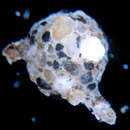Diagnosis
provided by World Register of Marine Species
Test free, large, up to 6.5 mm in diameter, a single spherical chamber with one to five narrow stolonlike arms radiating in various directions but usually in nearly the same plane and the longest ones commonly very flexible, may also have fragile conical projections, and may produce rounded buds (probably in asexual reproduction); protoplasmic body enclosed in a thick imperforate organic membrane with a single oral region; outside and slightly separated from this organic cover is a thin but very firm agglutinated wall incorporating coarse and fine sand and sponge spicules, commonly with a single layer of grains but may be up to 3 grains in thickness, with considerable brown to gray, acid mucopolysaccharide organic cement; pseudopodia projecting through the gelatinous capsule in the oral region of the organic shell occupy the space between it and the agglutinated test, and then. project through openings at the ends of the tubular arms. Holocene, at 78 m to 2,258 m depth; S. Atlantic: South Georgia; Antarctic; S. Pacific: New Zealand, North Island. (Loeblich & Tappan, 1987, Foraminiferal Genera and Their Classification)
Loeblich, A. R.; Tappan, H. (1987). Foraminiferal Genera and their Classification. Van Nostrand Reinhold Company, New York. 970pp.
- license
- cc-by-4.0
- copyright
- WoRMS Editorial Board

